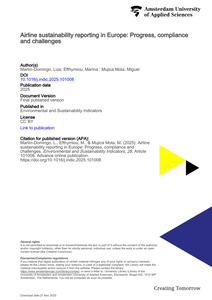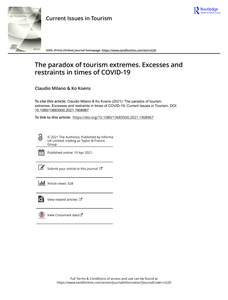This study systematically evaluates greenhouse gas (GHG) emissions reporting practices of European airline groups, covering both mandatory and voluntary key performance indicators (KPIs) under evolving regulatory frameworks. By analysing annual and sustainability reports from 16 major airline groups, the research identifies significant progress in the reporting of core metrics, with Scope 1 CO2 totals reported by 94 % and emissions intensity by 88 %, reflecting growing regulatory alignment and stakeholder expectations. However, persistent gaps remain: Scope 2 and Scope 3 reporting appears in only 56 % and 50 % of cases, respectively, while non-CO2 emissions are disclosed by just 38 %, despite forthcoming European Union Emissions Trading System (EU ETS) monitoring requirements. Reporting on sustainable aviation fuels (SAF) life-cycle emissions is limited (19 %), and CO2 offsetting disclosures are rare (6 %), complicating verification of decarbonisation claims and readiness for ReFuelEU Aviation and Carbon Offsetting and Reduction Scheme for International Aviation (CORSIA). The proliferation of voluntary KPI disclosures further complicates comparability due to a lack of standardization and clear definitions. These challenges are compounded by risks of greenwashing, where airlines selectively report favourable data such as emissions intensity, and greenhushing, where substantive achievements are under-communicated. The study concludes that while regulatory frameworks such as the Corporate Sustainability Reporting Directive (CSRD), the EU ETS, CORSIA, and ReFuelEU are driving improvements, further harmonization and methodological clarity are required to ensure transparency, comparability, and genuine progress toward aviation's climate goals.
DOCUMENT

Free newspapers may offer different news contents to different audiences, when compared with traditional, paid-for newspapers, but they, nevertheless, concentrate on news, and thereby provide society with information on current affairs. These papers have seen circulation rise until 2008; after that, a decline set in, leading to closures and often a monopoly situation in the mature European newspaper markets covered in our research. Free newspapers seem to follow a typical life cycle pattern, moving from growth to maturity, and to saturation and decline. Diversification strategies – home-delivery, weekend, sports, afternoon, and financial – have been disappointing so far. There is no evidence, however, of total extinction, indicating that there is room for at least one title – possibly two – in every market. The situation in the surveyed markets also suggests that a free newspaper may be a ‘natural’ monopoly.
DOCUMENT

The general aim of this research project has been to examine this phenomenon of tourism flow switching and consider the factors driving the geopolitical instability that can compromise destination security. On a more practical level the research has also examined what the reactions of Dutch tourists are to security threats affecting their tourism decisions and looked at the development of preventive measures against attacks by destinations and travel organisations. Finally, the research on the regional geopolitics of the MENA and European areas have together with the attitudes of Dutch tourists towards destination security been used as inputs into a scenario planning process involving the steering group of tour operators who originally commissioned this research, as participants. This process has focussed on macro environmental analysis, identification of key uncertainties, and the development of resilient strategies for the future.
DOCUMENT

What you don’t know can’t hurt you: this seems to be the current approach for responding to disinformation by public regulators across the world. Nobody is able to say with any degree of certainty what is actually going on. This is in no small part because, at present, public regulators don’t have the slightest idea how disinformation actually works in practice. We believe that there are very good reasons for the current state of affairs, which stem from a lack of verifiable data available to public institutions. If an election board or a media regulator wants to know what types of digital content are being shared in their jurisdiction, they have no effective mechanisms for finding this data or ensuring its veracity. While there are many other reasons why governments would want access to this kind of data, the phenomenon of disinformation provides a particularly salient example of the consequences of a lack of access to this data for ensuring free and fair elections and informed democratic participation. This chapter will provide an overview of the main aspects of the problems associated with basing public regulatory decisions on unverified data, before sketching out some ideas of what a solution might look like. In order to do this, the chapter develops the concept of auditing intermediaries. After discussing which problems the concept of auditing intermediaries is designed to solve, it then discusses some of the main challenges associated with access to data, potential misuse of intermediaries, and the general lack of standards for the provision of data by large online platforms. In conclusion, the chapter suggests that there is an urgent need for an auditing mechanism to ensure the accuracy of transparency data provided by large online platform providers about the content on their services. Transparency data that have been audited would be considered verified data in this context. Without such a transparency verification mechanism, existing public debate is based merely on a whim, and digital dominance is likely to only become more pronounced.
MULTIFILE

A literature review conducted as part of a research project named “Measuring Safety in Aviation – Developing Metrics for Safety Management Systems” revealed several challenges regarding the safety metrics used in aviation. One of the conclusions was that there is limited empirical evidence about the relationship between Safety Management System (SMS) processes and safety outcomes. In order to explore such a relationship, respective data from 7 European airlines was analyzed to explore whether there is a monotonic relation between safety outcome metrics and SMS processes, operational activity and demographic data widely used by the industry. Few, diverse, and occasionally contradictory associations were found, indicating that (1) there is a limited value of linear thinking followed by the industry, i.e., “the more you do with an SMS the higher the safety performance”, (2) the diversity in SMS implementation across companies renders the sole use of output metrics not sufficient for assessing the impact of SMS processes on safety levels, and (3) only flight hours seem as a valid denominator in safety performance indicators. At the next phase of the research project, we are going to explore what alternative metrics can reflect SMS/safety processes and safety performance in a more valid manner
DOCUMENT

Design educators and industry partners are critical knowledge managers and co-drivers of change, and design graduate and post-graduate students can act as catalysts for new ideas, energy, and perspectives. In this article, we will explore how design advances industry development through the lens of a longitudinal inquiry into activities carried out as part of a Dutch design faculty-industry collaboration. We analyze seventy-five (75) Master of Science (MSc) thesis outcomes and seven (7) Doctorate (PhD) thesis outcomes (five in progress) to identify ways that design activities have influenced advances in the Dutch aviation industry over time. Based on these findings, we then introduce an Industry Design Framework, which organizes the industry/design relationship as a three-layered system. This novel approach to engaging industry in design research and design education has immediate practical value and theoretical significance, both in the present and for future research. https://doi.org/10.1016/j.sheji.2019.07.003 LinkedIn: https://www.linkedin.com/in/christine-de-lille-8039372/
MULTIFILE

In this paper we turn to the field of innovation management and the use of metaphors to address the question: what kind of alternative metaphors and narratives have some open-innovation organizations introduced highlighting and fostering knowledge-intensive organizational change? First we draw a comparative overview of characteristics of knowledge flows in general, that are specific for open innovation strategies, and that organizations want to highlight. Then we describe the use of metaphors by Philips, Pfizer, Chevron and RABO on their way towards open innovation strategies. Methodologically, the interpretation of the described metaphors will be based on a metaphor theory derived from the works of Joseph Campbell, Mircea Eliade, Carl Gustav Jung and Eugen Drewermann. Our analysis concludes by providing guidelines for necessary future research about the aptness of innovation metaphors for idea generation and knowledge creation.
DOCUMENT
This paper seeks to highlight underlying issues of the tourism system that have led to tourism extremes of too much or too little tourism. Five phases are recognized that reflect different ways of dealing with too much tourism over time, after which the impact of a sudden lack of tourism is investigated in light of future renewal processes. This discussion highlights the remarkable capacity of the tourism industry to adjust to rapidly changing circumstances and crises, even when these cause anguish to individuals and within societies at large. The paper thus seeks to contextualize the current discussions regarding the transformation of tourism post COVID-19. It highlights the complexity of changing a tourism that multiple stakeholders depend on or have grown accustomed to. To come to a more balanced tourism, it is necessary to not only come up with alternative visions and strategies, but also to engage with the political economy nature of tourism development. A future research agenda should therefore also discuss facets of entangled power, social exclusion, inequalities and class differences to come to new reference points of what actually constitutes a more inclusive tourism success.
MULTIFILE

By use of a literature review and an environmental scan four plausible future scenarios will be created, based on the research question: How could the future of backpack tourism look like in 2030, and how could tourism businesses anticipate on the changing demand. The scenarios, which allow one to ‘think out of the box’, will eventually be translated into recommendations towards the tourism sector and therefore can create a future proof company strategy.
DOCUMENT

Dit rapport is een aanvulling op de de toekomstvisie van het NBTC betreffende het inkomend toerisme in Nederland. Als aanvullende input voor genoemde toekomstvisie heeft het NBTC aan ETFI gevraagd om met behulp van een scenariostudie te komen tot (betere) ramingen van de omvang van het internationaal verblijfsbezoek aan Nederland richting 2030. Een dergelijke studie kan helpen bij het identificeren van onzekerheden en het bepalen van bandbreedtes. De doelstelling was als volgt omschreven: Op interactieve wijze een aantal toekomstscenario’s ontwikkelen die helpen bij het identificeren van onzekerheden en het bepalen van bandbreedtes waarbinnen het internationaal verblijfsbezoek zich op de (middel)lange termijn kan gaan ontwikkelen.
DOCUMENT
